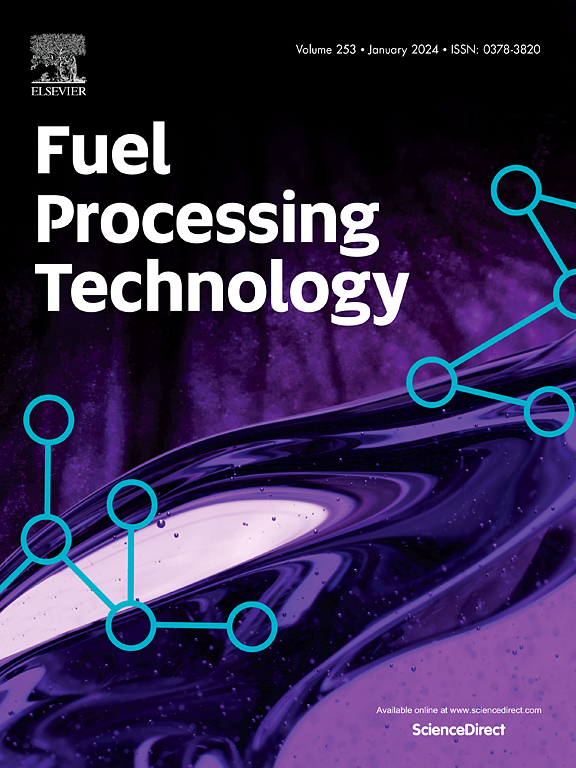Understanding the deposition mechanism burning Fe - rich Zhundong coal in a 0.4 MW pilot-scale facility
IF 7.7
2区 工程技术
Q1 CHEMISTRY, APPLIED
引用次数: 0
Abstract
This study presents a comprehensive investigation of slagging characteristics associated with Fe-rich Zhundong coal (ZDC) combustion utilizing a 0.4 MWth pilot-scale facility. Slag specimens collected from three critical locations - bottom-of-furnace (BOF), superheater, and reheater zones - were systematically characterized through multi-analytical approaches including X-ray fluorescence (XRF), X-ray diffraction (XRD), and scanning electron microscopy (SEM) with energy-dispersive X-ray spectroscopy (EDS), complemented by molecular dynamics simulations to elucidate microscopic deposition mechanisms. Key findings reveal that: Distinct melting phenomena were observed across all sampling locations under flue gas temperatures (FGT) ranging from 1000 to 1350 °C, primarily attributed to both the formation of Si![]() Ca low-temperature eutectic phases and fluxing effects of Fe-bearing material. Comparative analysis identified sulfate-induced contamination in reheater deposits at moderate-to-low FGT regimes (1000–1200 °C), demonstrating deposition characteristics analogous to Ca-rich ZDC slag formations. The interaction mechanisms of sulfur in reheater zones promoted Fe
Ca low-temperature eutectic phases and fluxing effects of Fe-bearing material. Comparative analysis identified sulfate-induced contamination in reheater deposits at moderate-to-low FGT regimes (1000–1200 °C), demonstrating deposition characteristics analogous to Ca-rich ZDC slag formations. The interaction mechanisms of sulfur in reheater zones promoted Fe![]() Na synergistic effects. The slag produced through low-temperature ashing exhibits lower fusion temperatures. Molecular dynamics simulations further confirmed that elevated combustion temperatures facilitate Si
Na synergistic effects. The slag produced through low-temperature ashing exhibits lower fusion temperatures. Molecular dynamics simulations further confirmed that elevated combustion temperatures facilitate Si![]() Ca eutectic formation while promoting preferential deposition of Na2SO4/ CaSO4 on low-temperature heat exchange surfaces. When using Fe-rich ZDC in the ∏-type boiler, the FGT at the furnace outlet needs to be reduced to at least 1000 °C.
Ca eutectic formation while promoting preferential deposition of Na2SO4/ CaSO4 on low-temperature heat exchange surfaces. When using Fe-rich ZDC in the ∏-type boiler, the FGT at the furnace outlet needs to be reduced to at least 1000 °C.
了解在0.4 MW中试装置上燃烧富铁准东煤的沉积机理
本研究利用0.4 mw中试装置对富铁准东煤(ZDC)燃烧的结渣特性进行了全面研究。通过x射线荧光(XRF)、x射线衍射(XRD)、扫描电子显微镜(SEM)和能量色散x射线能谱(EDS)等多种分析方法,并辅以分子动力学模拟来阐明微观沉积机制,收集了三个关键位置——炉底(BOF)、过热器和再热器区域的炉渣样品。主要发现表明:在烟气温度(FGT)范围从1000°C到1350°C的所有采样地点都观察到明显的熔化现象,主要归因于二氧化硅低温共晶相的形成和含铁材料的助熔剂效应。对比分析发现,在中低FGT状态下(1000-1200°C),再热器沉积物中存在硫酸盐引起的污染,表明沉积特征类似于富钙的ZDC渣形成。再热器区硫的相互作用机制促进了fea的协同效应。低温灰化产生的炉渣表现出较低的熔合温度。分子动力学模拟进一步证实,升高的燃烧温度有利于二氧化硅共晶的形成,同时促进了Na2SO4/ CaSO4在低温换热表面的优先沉积。在∏型锅炉中使用富铁ZDC时,炉口的FGT至少需要降低到1000℃。
本文章由计算机程序翻译,如有差异,请以英文原文为准。
求助全文
约1分钟内获得全文
求助全文
来源期刊

Fuel Processing Technology
工程技术-工程:化工
CiteScore
13.20
自引率
9.30%
发文量
398
审稿时长
26 days
期刊介绍:
Fuel Processing Technology (FPT) deals with the scientific and technological aspects of converting fossil and renewable resources to clean fuels, value-added chemicals, fuel-related advanced carbon materials and by-products. In addition to the traditional non-nuclear fossil fuels, biomass and wastes, papers on the integration of renewables such as solar and wind energy and energy storage into the fuel processing processes, as well as papers on the production and conversion of non-carbon-containing fuels such as hydrogen and ammonia, are also welcome. While chemical conversion is emphasized, papers on advanced physical conversion processes are also considered for publication in FPT. Papers on the fundamental aspects of fuel structure and properties will also be considered.
 求助内容:
求助内容: 应助结果提醒方式:
应助结果提醒方式:


